www.rhci-online.net/radiogram/radiogram.htm
██╗██████╗ ██████╗ ██████╗ █████╗ ██████╗ ██╗ ██████╗ ██████╗ ██████╗ █████╗ ███╗ ███╗
██║██╔══██╗██╔════╝ ██╔══██╗██╔══██╗██╔══██╗██║██╔═══██╗██╔════╝ ██╔══██╗██╔══██╗████╗ ████║
██║██████╔╝██║ ██████╔╝███████║██║ ██║██║██║ ██║██║ ███╗██████╔╝███████║██╔████╔██║
██║██╔══██╗██║ ██╔══██╗██╔══██║██║ ██║██║██║ ██║██║ ██║██╔══██╗██╔══██║██║╚██╔╝██║
██║██████╔╝╚██████╗ ██║ ██║██║ ██║██████╔╝██║╚██████╔╝╚██████╔╝██║ ██║██║ ██║██║ ╚═╝ ██║
╚═╝╚═════╝ ╚═════╝ ╚═╝ ╚═╝╚═╝ ╚═╝╚═════╝ ╚═╝ ╚═════╝ ╚═════╝ ╚═╝ ╚═╝╚═╝ ╚═╝╚═╝ ╚═╝
START START START START
QUESTA E' IBC, ITALIAN BROADCASTING CORPORATION
OGNI MERCOLEDI' 20-22 UTC 6070 KHZ IN ITALIANO
website: HTTP://WWW.IBCRADIO.WEBS.COM
email: IBC@EUROPE.COM
.
..
.
|
Sending Pic:500x187Cp4;
|
via Frank Kreuzinger /
Pirna: |
|

|

pic_2016-06-17_203316z.png
|
|
facebook: |
|
|
 |

pic_2016-06-15_202817z.png
|
|
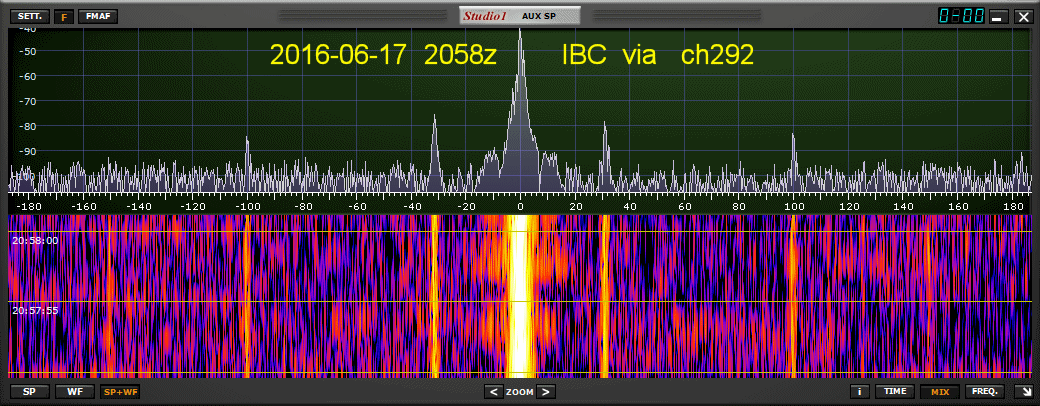
|
<<2016-06-17T20:30Z
MFSK-32 @
6070000+1500>>
(NO RSID)
"IBC DIGITAL" "IBC DIGITAL" "IBC DIGITAL" "IBC DIGITAL"
OGNI MERCOLEDI' 20.30-21.00 UTC 6070 KHZ AM
TRASMETTIAMO:
--"RADIOPASSIONI" A CURA DI ANDREA LAWENDEL, IN MFSK 32 (1500 Hz)
--"DX NEWS DX ITALIA", NOTIZIE PER RADIOMATORI TRATTE DAL BOLLETTINO DI
I2MQP,
IN OLIVIA 16-500 (2200 Hz)
BUONA DECODIFICA!
"RADIOPASSIONI" "RADIOPASSIONI" "RADIOPASSIONI"
( http://www.radiopassioni.it/
)
Radiopassioni on-air: i post si leggono sulle onde corte di IBC !
Radiopassioni non viene più aggiornato molto frequentemente - è un periodo in
cui purtroppo non mi è facile trovare abbastanza tempo - ma in compenso i suoi
contenuti trovano nuove piattaforme di distribuzione! Grazie a IBC Italian
Broadcasting Corporation ( http://ibcradio.webs.com/
), una selezione dei miei
post viene ora diffusa in modalità digitale attraverso le onde corte
analogiche, utilizzando le codifiche radioamatoriali MFSK32 e Olivia 16-500.
La trasmissione ha luogo ogni mercoledì nello slot dalle 20 alle 22 UTC che
IBC si è assicurata sulla frequenza europea di 6070 kHz, dalla Germania. La
prima trasmissione ha avuto luogo ieri, 8 giugno, ma lo spazio di IBC Digital
dovrebbe essere regolare, tra le 20:30 e le 21 UTC. Radiopassoni condivide la
fascia testuale del programma IBC con "DX News DX Italia". Le due modalità di
trasmissione si possono decodificare facilmente utilizzando il software
cross-platform FlDigi ( http://www.w1hkj.com/
) e a differenza di quanto
avviene normalmente con questo tipo di emissioni non occorre avere un
ricevitore in grado di ricevere trasmissioni in CW o in banda laterale. In
questo caso la banda-base del segnale digitale viene infatti diffusa in
modulazione d'ampiezza, generando l'audio che serve ad alimentare l'ingresso
del computer utilizzato per FlDigi.
D'accordo con la redazione di IBC, Radiopassioni in futuro andrà in onda anche
con una programmazione audio. Sto pensando a come produrre questa nuova veste
di RP, per il quale sto da tempo meditando una uscita on-air o podcast. La
trasmissione verrà inserita nella programmazione IBC in onda, oltre che sul
relay di 6070, sulle frequenze proprie di 3930 e 6970USB che IBC impegna tutti
i martedì e i giovedì tra le 18 e le 21 UTC.
Lasciatemi dire che sono molto contento che Radiopassioni possa essere
associato a una stazione "non autorizzata" (in realtà i 6070 del relay sono
regolarissimi) che ha fatto la storia delle trasmissioni hobbystiche in
Italia. IBC oltretutto nasce per iniziativa di amici con i quali ho condiviso
decenni di militanza nella DX community italiana. Nel frattempo la radiofonia
in onde corte è cambiata radicalmente, là fuori non ci sono più tutte quelle
stazioni da ascoltare. Ma per un verso o per l'altro l'hobby è ancora
pimpante, anche se tanti broadcaster internazionali e domestici hanno
abbandonato le HF. I veterani si consolano con le onde medie, gli SWL
continuano a seguire le trasmissioni dei radioamatori, la ricezione a lunga
distanza in FM, anche se stagionale, è una inesauribile fonte di emozioni. E
poi c'è tutto il comparto delle trasmissioni civili e militari HF a carattere
utilitario, inclusa la nicchia dei radiofari in LF. Insomma, tante occasioni
di sperimentazione della ricezione on-air e tante, tantissime storie da
raccontare su una radiofonia ormai indissolubilmente integrata con Internet e
aperta a nuove modalità digitali.
Una frequenza per Expressa: il giovane radiocronista ucciso dalla trucha
simbolo della riforma delle Tlc in El Salvador.
La storia del giovane salvadoreño Nicolás Humberto García sembra scaturire dal
genio letterario di un Bolaño ma è tragicamente vera per la famiglia del
23enne ucciso con brutale ferocia dalla Mara Salvatrucha e per la piccola
comunità del rione di Tacuba, El Salvador, che rappresentava il pubblico
"radiofonico" di Nicolás. Al caso dello sfortunato radio-maker ha dato risalto
internazionale (
https://cpj.org/2016/03/director-of-community-radio-station-murdered-in-el.php
) il CPJ, la ong che cerca di sensibilizzare l'opinione
pubblica internazionale sui delitti che colpiscono in prima persona i
giornalisti e i corrispondenti, in modo particolare gli omicidi a sfondo
politico, direttamente connessi al potere o alla criminalità organizzata.
Delitti, aggiungo io, che quasi sempre rimangono impuniti anche quando
esecutori e mandanti sono perfettamente noti. La morte di García risale al 17
marzo e si inserisce in un contesto di aspra discussione, anche parlamentare,
sulle norme che in Salvador regolano l'accesso alle frequenze radio-
televisive. La giovane vittima lavorava per una stazione radio denominata
"Expressa, Voces al aire" basata nella comunità El Carrizal, in un quartiere
chiamato El Jícaro, a Tacuba, piccolo centro nella giungla al confine tra El
Salvador e Guatemala. Non posso dirvi la frequenza di Expressa semplicemente
perché Expressa non ha un frequenza: l'emittente è poco più di un mixer
collegato a un amplificatore e a un sistema di casse collegate da fili
appoggiati sui rami degli alberi. La stampa salvadoreña ha avanzato l'ipotesi
che Nicolás - che lavorava per la sua radio da quando aveva quindici anni -
avesse subito le angherie della trucha che insisteva per raccogliere,
attraverso la radio, informazioni sui movimenti della polizia nella zona. Le
associazioni locali dei media comunitari e per la libertà di stampa, ARPAS (
http://www.arpas.org.sv/
) in testa, hanno respinto queste ipotesi, giudicate
offensive per i familiari di Nicolás. Ma le dinamiche del delitto sembrano
invece confermarle.
La morte di Nicolás è diventato subito un simbolo della lotta per una maggiore
democrazia nell'etere di El Salvador, la cui Corte costituzionale aveva
imposto al Parlamento un urgente intervento sulla normativa in vigore. In
seguito a quella sentenza, organismi come la RedCo
(
http://www.diariocolatino.com/redco-solicita-reformas-a-la-ley-de-telecomunicaciones/
), la Red por el Derecho a la Comunicación, appoggiata
dalla deputata del Frente Farabundo Martí para la Liberación Nacional (FMLN),
Jacqueline Rivera, avevano chiesto che il governo promuovesse una riforma
favorevole alle emittenti comunitarie. Per dare a entità come Radio Expressa
la possibilità di trasmettere per davvero. Alla fine di marzo, Nicolás ha
avuto il suo postumo riconoscimento: i deputati salvadoreñi hanno raggiunto un
accordo (
http://www.elsalvador.com/articulo/nacional/diputados-logran-acuerdo-reforma-ley-telecomunicaciones-106061
) che modificherà la legge delle
telecomunicazioni introducendo, accanto al meccanismo delle aste riservate
alle imprese radiotelevisive commerciali che intendono aggiudicarsi una
frequenza su cui trasmettere, anche quello del concorso pubblico, che
assegnerà liberamente una quota di frequenze a emittenti comunitarie, non a
scopo di lucro (che dovranno limitare la loro potenza trasmissiva e impegnarsi
a non "rivendere" le loro autorizzazioni). Adesso solo il Parlamento che potrà
scrivere la parola fine in fondo alla storia. La proposta di riforma non è
priva di oppositori, a incominciare dalle società telefoniche che temono
conseguenze sul numero di frequenze a loro disposizione.
END END
"RADIOPASSIONI" "RADIOPASSIONI" "RADIOPASSIONI"
( http://www.radiopassioni.it/
)
"IBC DIGITAL" "IBC DIGITAL"
SWITCH NOW TO OLIVIA 16-500(2200 Hz)
<<2016-06-17T20:44Z
OLIVIA 16-500 @
6070000+2200>>
(NO RSID)
START START
.
.
"IBC DIGITAL" "IBC DIGITAL"
"DX NEWS DX ITALIA" "DX NEWS DX ITALIA"
STAZIONI IN ARIA ORA O ENTRO UNA SETTIIMANA
3B8 Mauritius Jun 15 - Jul 14 M0RCX will operate /3B8 qsl EB7DX
3DA Swaziland NOW ZS6AYE is on digital modes as 3DA0AY qsl OQRS
5W Samoa Jun 15 - Jul 15 KC0W as 5W0COW qsl H.C. dir only
5X Uganda Now - Jul 8 KK7PW as 5X1O qsl EA5GL
8T Antartica Now - Dec 2016 VU3BPZ as BT2BH qsl I1HYW
9M2 W.Malaysua Now - Jun 15 DF5UG as 9M2QQ qsl H.C.
C5 Gambia Now - Jun 18 JM1CAX as C5NX. qsl H.C.
D2 Angola NOW CT1CRS as D2XX qsl H.C.
DL Germany Jun 5 - Jul 4 DF8HS from EU-128 qsl Bur
FJ St.Barthelemy Jun 17 - Jun 29 W9DR & W9AEB as /FJ qsl H.C.
FS St. Martin Jun 2 - Jun 21 K9EL as /FS qsl H.C & ClubLog
FS St. Martin Jun 11 - Jun 25 W5LAC as /FS qsl H.C.
I Italy Now - Jul 1 IU2HDO as /IF9 from EU-054 qsl H.C.
J6 St. Lucia Now - Jun 19 K9HZ as J68HZ qsl Dir LoTW ClubLog
JX Jan Mayen Apr 12 - Oct 4 LA9JKA as JX9JKA qsl H.C. dir only
LA Norway Jun 11 - Jun 18 DK3PZ from EU-055 /LA qsl Bur
LX Luxemburg Jun 17 - Jun 19 LX8SAR activity Bureau
OX Greenland Jun 19 - Jun 24 JK1FNL as OX/NA8O qsl Dir Bur LoTW
PJ7 S.Maarten Jun 11 - Jun 25 W5LAC as /PJ7 qsl H.C.
RI1 Antartica now to Apr17 RW1AI as RI1AND from AN-016 qsl RW1AI
SV Greece Jun 10 - Jun 24 PA1FJ as /SV8 from EU-049 qsl H.C.
SV Greece Jun 17 - Jul 6 GM0LVI as /SV8 from EU-052 qsl H.C.
TK Corsica Jun 19 - Jun 24 F5OHM as /TK qsl H.C.
UA Russia Jun 3 - Sep 3 RI1C team from EU-133 qsl RW1F OQRS
V3 Belize Now - Oct end PA0C as V31HV & V31HV/p H.C. dir
ZF Cayman Jun 3 - Jun 17 2M0JMN AS ZF2MN qsl H.C. dir bur LoTW
END END
"DX NEWS DX ITALIA" "DX NEWS DX ITALIA"
"IBC DIGITAL" "IBC DIGITAL"
END END END
██████╗ ██╗ ██████╗ ██╗ ██████╗ ██╗ ██╗
██╔══██╗██║██╔════╝ ██║ ██╔══██╗╚██╗██╔╝
██║ ██║██║██║ ███╗██║ ██║ ██║ ╚███╔╝
██║ ██║██║██║ ██║██║ ██║ ██║ ██╔██╗
██████╔╝██║╚██████╔╝██║ ██████╔╝██╔╝ ██╗
╚═════╝ ╚═╝ ╚═════╝ ╚═╝ ╚═════╝ ╚═╝ ╚═╝
RSID: <<2016-06-13T20:00Z
MFSK-32 @
6070000+1500>>
Hello and welcome to DigiDX 17 , a weekly review of the latest shortwave and DX
news broadcast mainly in MFSK32 mode. This broadcast includes shortwave news,
Alan Roe’s Music on Shortwave guide and the over-the-air QSL card.
DigiDX weekly schedule:
Sunday 2130 - 15770kHz via WRMI (Okeechobee, FL, USA)
Sunday 2330 - 11580kHz via WRMI (Okeechobee, FL, USA)
Monday 2000 - 6070kHz via Channel 292 (Rohrbach Wall, DE)
Daily 0530/1830 - 6070kHz via Channel 292 (Rohrbach Wall, DE)
Thanks to Channel 292 broadcasting the extra daily repeats of DigiDX, to buy
shortwave time from Channel 292 at very reasonable prices go to
http://www.channel292.de.
Any other extra broadcasts will be listed on http://www.digidx.uk
If you enjoy DigiDX and find the service useful please consider donating via
Paypal to reports@digidx.uk
or via our Patreon page. Any money donated will go
towards paying for airtime to keep DigiDX on the air to Europe and North
America.
Every donation will help no matter how little -
https://www.patreon.com/digidx
/
reports@digidx.uk
Thanks very much to listeners Alan Gale, Jordan Heyburn, Fred Albertson, Mike
Stapp, Mark Braunstein and Richard Langley for contributing to the Patreon
campaign.
Latest Shortwave News:
IBB Iranawila transmitting site closed
Radio Publique Africaine clandestine station starts broadcasts
Radio Republik Indonesia to increase power of broadcasts
VOA Burmese correction
IBB Iranawila transmitting site closed
The IBB transmitter site in Iranawila, Sri Lanka has been closed down as of the
6th of June 2016. The site which only opened in 1999 was used to broadcast Radio
Liberty, Radio Free Asia, VOA, Radio Mashaal and Radio Farda for around 47 hours
of programming per day in
the A16 season.
The reason for the closure is the cost to run the station and the fact that 1/4
of a million bolts on the antenna systems need to be replaced. The latest annual
report from BBG/IBB suggested that the Kuwait transmitter site would be expanded
at the expense of other
sites due to the low cost of electricity in the Arab state.
Glenn Hauser from DX Listening Digest and World of Radio who provided this news
also has mentioned that a rumour is that one of the two IBB sites in Germany
will also close this year - either Biblis or Lampertheim.
Transmissions from Iranawila have be moved to other IBB stations in Thailand,
Germany, Kuwait, the Philippines and the Northern Mariana Islands. Some
transmissions have also been moved to Woofferton, UK and Armenia, presumably via
Babcock.
Radio Publique Africaine clandestine station starts broadcasts
A clandestine station aimed at Burundi broadcasting in local languages and
French has started daily from 1800-1900UTC on 15480kHz. Radio Publique Africaine
was previously broadcast on FM in the country but was closed down in the wake of
an attempted coup in May 2015.
The broadcast is from the Issoudun transmitter in France.
Radio Republik Indonesia to increase power of broadcasts
Radio Republik Indonesia will increase transmitter power of its stations located
in remote and border areas. According to the RRI director of new technologies
and media this is to “strengthen nationalism”. The German service of Voice of
Indonesia reported that RRI
will start by increasing the power of one station in West-Kalimantan province.
From 5kW to 10kW in 2017. This could be RRI Palangkaraya which broadcasts on
3325kHz.
VOA Burmese correction
Last week DigiDX had a news story about VOA Burmese reducing hours on shortwave,
however thanks to Kim Andrew Elliott it has been clarified that this story is
not correct and was assumed
due to another false story about VOA Bangla re-starting on shortwave. VOA
Burmese continues on its normal A16 schedule and VOA Bangla in the Bengali
language will still only be on 1575kHz
MW from Thailand.
Upcoming relays and special broadcasts:
Alaska based SWL Paul Walker has a repeat of his latest Classic Experience
broadcast via Shortwave Service in Germany this week. The two hour broadcast
also features some MFSK32 text (in the 2nd half hour of the broadcast) and an
image (in the final half hour).
The schedule is as follows:
6005kHz Friday June 24th 1800-2000
3985kHz Saturday June 25th 0000-0200
Reception reports are only accepted by regular postal mail and $2 is appreciated
to cover the costs of the QSL cards and return postage:
Paul B. Walker, Jr.
PO Box 353
Galena,
Alaska 99741
USA
VOA Radiogram will be on air this weekend on the following frequencies, for more
information on the modes to be used visit http://voaradiogram.net/
Sat 0930-1000 5745 kHz
Sat 1600-1630 17580 kHz
Sun 0230-0300 5745 kHz
Sun 1930-2000 15670 kHz
All broadcasts are from Greenville, NC.
IBC - Italian Broadcasting Corporation has added a digital mode broadcast to
weekly broadcast via Channel 292 on 6070kHz.
The entire broadcast is Wednesday 2000 to 2200 UTC, with MFSK32 followed by
Olivia 16-500 at 2030-2100 UTC. The text includes DX and amateur radio news.
Now follows Alan Roe’s music on shortwave listening guide for at A16 season,
this programme includes the guide from 1900-0000UTC.
Start - Stop Days Su-W-Sa
Station Pgm Programme Title
Frequencies
2000 ------ ------
------
2000 - 2030 su V of
America FR RM Show: Du Blues au Jazz 6070-sa
9490-kt 11900-sa 15730-gr 17530-gr
2000 - 2030 mo V of
America FR RM Show: Le hit-parade americain 6070-sa
9490-kt 11900-sa 15730-gr 17530-gr
2000 - 2030 tu V of
America FR RM Show: Antenna Libre 6070-sa
9490-kt 11900-sa 15730-gr 17530-gr
2000 - 2030 we V of
America FR RM Show: Musique internationale 6070-sa
9490-kt 11900-sa 15730-gr 17530-gr
2000 - 2030 th V of
America FR RM Show - Afro music 6070-sa
9490-kt 11900-sa 15730-gr 17530-gr
2000 - 2030 fr V of
America FR RM Show: La musique des caraibes 6070-sa
9490-kt 11900-sa 15730-gr 17530-gr
2000 - 2056 daily V of
Turkey(TSR) TU Often has Turkish music 5960 9460
2000 - 2100 su R
Marti SP
Archivo Musical 9565-gr 11930-gr
2000 - 2100 mo WWCR
EN Inspirations Across America (Gospel Rock) 9350
2000 - 2100 mo-sa WRMI
EN World Music 11580-ok
2000 - 2100 daily Channel
292 relays EN/var Non-stop mx & var. relays, incl:(v)
6070-rh
we: Italian
Broadcasting Co
sa: SM Radio Int (Ron O'Quinn)
su: Flying Circus Rock
Show (varies)
2000 - 2100 daily Europa
24 GM Non-stop mx 6150-da
2000 - 2100 daily R Denge
Kurdistan VV Mostly Kurdish music 11600-bu
2000 - 2100 daily R Farda
FS ME mx (some West mx & talk) 5865-kt
2000 - 2100 daily (irr) ERT V of
Greece GK Usually varied Greek mx 9420 9935
2000 - 2100 daily Zanzibar
B. Co VV Usually African/local music 11735
2000 - 2100 sa,su V of
America EN Music Time in Africa 4930-bo
4940-sa(2130-) 6195-bo 15580-bo
2000 - 2100 mo-fr V of
America EN African Beat 4930-bo
6195-bo 15580-bo
2005 - 2058 su
Medi 1
FR La bossa nova (Sanae)
9575
2005 - 2058 sa
Medi 1
FR Sélection Reggae (Sanae)
9575
2005 - 2058 mo-th
Medi 1 FR
Les Nocturnes (Jawad) 9575
2007 - 2055 su R
Liberty RU Jazz Time 5995-la
7475-ir 9540-la (-19 June)
2010 - 2027 sa R
Tirana EN Folk Traditional Music 7465
2010 - 2057 su KBS
World R FR Musique coréenne 5950-fr
2010 - 2057 su KBS
World R GM Unterwegs mit Musik (pop) 3955-wo
2010 - 2100 sa,su R France
Int - Af FR Musiques du monde 7205 9790 11995
2010 - 2100 mo-fr R France
Int - Af FR La bande passante 7205 9790 11995
2010 - 2100 mo-fr R France
Int - World FR
Couleurs Tropicales 3965-drm
couleurs_tropicales_1_20160616.mp3
2015 - 2027 fr R
Tirana EN Music (modern) 7465
2015 - 2027 we R
Tirana EN Hits Through the Years 7465
2015 - 2030 daily China R
Int Srb Varied Western/CC pop/rock 7325-ur 7390-xi
9585-ka
2020 - 2027 th R
Tirana EN Music (modern) 7465
2030 - 2055 daily China R
Int PO Chinese Popular Music 6020-sz 7305-ur
2040 - 2055 su China R
Int IT Music from China 7265-ur 7345-ka
2045 - 2055 sa V of
Vietnam EN Weekend Music 7220 7280
9550 9730
2045 - 2057 we KBS
World R FR Aux sources de la musique coréenne 5950-fr
2045 - 2057 we KBS
World R GM Musik verbindet (Traditional) 3955-wo
2050 - 2100 daily All
India R GOS EN Hindustani light or Karnatic mx, or Regional/folk song
7550 9445 9910 9950 11620 11670 11740
2100 ------ ------
------
2100 - 2130 sa WRMI
EN R Northern Ireland 15770-ok
2100 - 2130 sa WWCR
EN Musical Memories 15825
2100 - 2200 daily Channel
292 relays EN/var Non-stop mx & var. relays, incl:(v)
6070-rh
we: Italian Broadcasting Co
su: R Waves Int (ocassional)
2100 - 2200 daily R Farda
FS ME mx (some West mx & talk)
5865-kt
2100 - 2200 su
WBCQ EN
Marion's Attic
7490
http://schedule.wbcq.com/index.php
2100 - 2200 daily (irr) ERT V of
Greece GK Usually varied Greek mx 9420 9935
2100 - 2200 fr V of
America EN Music Time in Africa 6195-bo
15580-bo
2100 - 2200 fr WBCQ
EN Behaviour Night 7490
2105 - 2120 daily V of
Turkey EN Music selection (varying time) 7205
2105 - 2200 mo V of
America EN
VOA1 - The Soul Lounge 6195-bo 15580-bo
2105 - 2200 th V of
America EN
VOA1 - Top 20 countdown 6195-bo 15580-bo
2105 - 2200 su V of
America EN
VOA1 - Country Hits USA 6195-bo 15580-bo
2105 - 2200 tu,we,sa V of
America EN
VOA1 - The Hits 6195-bo 15580-bo
2110 - 2130 daily All
India R GOS EN Hindustani classical or instrumental music (various
day/time) 7550 9445 9910 9950 11620 11670 11740
2112 - 2158 mo-th
Medi 1 FR
Les Nocturnes (Jawad) 9575
2115 - 2130 daily China R
Int Srb Varied Western/CC pop/rock 7325-xi 7445ku
2115 - 2158 sa
Medi 1
FR Goldies
9575
2115 - 2158 su
Medi 1
FR Jazz Session (Jawad)
9575
2120 - 2130 th R
Romania Int SP Music Programme 15170
17745
2130 - 2140 tu R
Romania Int SP Folk Music Programme 15170
17745
2130 - 2140 fr R
Romania Int SP Romanian Folk Music 15170
17745
2130 - 2140 sa R
Romania Int SP Top Musical (pop) 15170
17745
2130 - 2200 we
WBCQ EN
Goddess Irena 1 Music Show
7490
http://schedule.wbcq.com/index.php
2130 - 2200 th WRMI
EN Blues Radio International 13695-ok
2130 - 2200 daily All
India R GOS EN Film music (various times) 7550 9445
9910 9950 11620 11670 11740
2133 - 2200 sa R France
Int - World FR L'epopee des musiques noires 3965-drm
2150 - 2157 m-f (irr) V of
America VV African music (irreg) 4940-sa
6035-sa 7325-va 9490-sa 11900-va
2200 ------ ------
------
2200 - 2300 occ European
Music R EN Mostly oldies 7490-wbcq (15
Oct)
2200 - 2300 daily Channel
292 relays EN/var Non-stop mx & various relays 6070-rh
2200 - 2300 daily HCJB
Deutsche GM Ichtys R Live 3995-we
2200 - 2300 daily R Farda
FS ME mx (some West mx & talk) 5865-kt
2200 - 2300 daily (irr) ERT V of
Greece GK Usually varied Greek mx 9420 (& check
9935)
2210 - 2257 su KBS
World R EN K-Pop Interactive 11810
2210 - 2258 mo-th
Medi 1 FR
Les Nocturnes (Jawad) 9575
2230 - 2240 mo R
Romania Int EN Your Music 7325 7430
9760 9790
2230 - 2240 su R
Romania Int EN Music Time 7325 7430
9760 9790
2230 - 2240 tu,fr R
Romania Int EN Truly Romanian 7325 7430
9760 9790
2230 - 2240 we,th R
Romania Int EN Music Highlights (Classical mx) 7325 7430
9760 9790
2230 - 2240 sa R
Romania Int EN All That Jazz 7325 7430
9760 9790
2235 - 2250 daily V of
Turkey EN Music selection (varying time) 9830
2245 - 2257 we KBS
World R EN Sounds of Korea 11810
2245 - 2300 daily All
India R GOS EN Devotional Music 9690 9705
11645 11710 13605-drm
2300 ------ ------
------
2300 - 2315 sa WRMI
EN Hymns 11580-ok
2300 - 2330 sa WWCR
EN Talking Machine Show 9350
2300 - 2400 mo WWCR
EN World Wide Country Radio 9350
2300 - 2400 fr
WBCQ EN
Fred
Flintstone's Music Show
7490
http://schedule.wbcq.com/index.php
2300 - 2400 daily R Farda
FS ME mx (some West mx & talk) 5865-kt
2300 - 2400 daily (irr) ERT V of
Greece GK Usually varied Greek mx 9420 (& check
9935)
2300 - 2400 mo WWCR
EN Last Radio Playing (Blues) 9350
2306 - 2400 we BBC WS -
e&seAS EN Global Beats (Monthly) 5840-th 6195-kr
9740-kr 9890-th 11850-kr 12010-th
2315 - 2330 daily All
India R GOS EN Hindustani light or Karnatic mx, or Regional/folk song
9690 9705 11645 11710 13605-drm
2320 - 2330 th R
Romania Int SP Music Programme 9760 11795
13730 15400
2330 - 2340 tu R
Romania Int SP Folk Music Programme 9760 11795
13730 15400
2330 - 2340 fr R
Romania Int SP Romanian Folk Music 9760 11795
13730 15400
2330 - 2340 sa R
Romania Int SP Top Musical (pop) 9760 11795
13730 15400
2330 - 2400 fr R
Australia EN Oz Country Style 15240
15415 17840
2335 - 2357 su R Havana
Cuba EN From Havana (2-weekly) 5040 11880
2340 - 2357 sa R Havana
Cuba EN Music with a Message alt with The Jazz Place 5040 11880
2345 - 2355 sa V of
Vietnam EN Weekend Music 9840 12020
We conclude this broadcast with this weeks E-QSL card, sent as an MFSK32 image.
The background image is the VOA Iranawila transmitter site. Sorry for the issue
on the 15770kHz broadcast via WRMI which went off
air after 6 minutes due to a power cut in Okeechobee, Florida. The image is sent
first as a PNG file (89.7KB) and then as a
JPEG file (39.9KB). This follows up
on Merkouris from Greece’s comments regarding the larger
size of images when the decode has more errors in it.
Merkouris also looked at the Olvia 4-125 text broadcast on the 0530/1830
transmissions on Channel 292 and observed:
“The Olivia mode, which was centered at 1500 Hz, could also be decoded with the
center frequency set anywhere between 1351 Hz and 1647 Hz! Please see the second
attachment showing again 3 running
instances of fldigi. A closer look at the screenshot reveals that fldigi reports
the frequency offset at the bottom of each window: f/o +0.0 Hz when the decoder
is centered at 1500 Hz and f/o +125 Hz or -125 Hz for
the other two center frequencies. While the reported by fldigi frequency offsets
are not very accurate, it seems that the software can decode the Olivia 4-125
mode even though the decoder's center frequency is
not set on the spot. In fact, the center frequency can be set to the actual
frequency plus/minus 145 Hz approximately.”
DigiDX will carry out more tests in Olivia 4-125 and other modes in the coming
episodes, including some on WRMI transmissions.
|
Sending Pic:466x266;
|
Sending Pic:466x266;
|
|
|
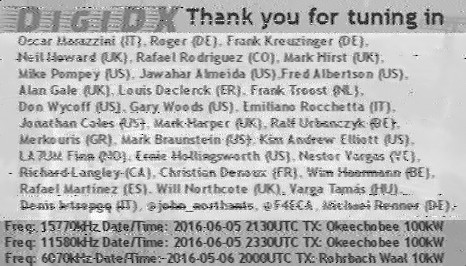 |
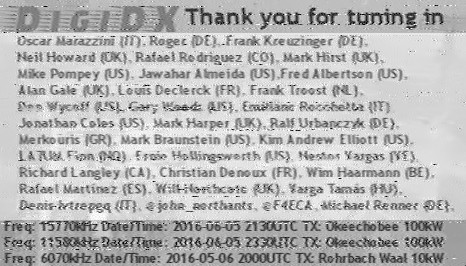 |
I do not understand the intention
of this experiment.
FLDIGI must transmit (in both cases) image informationen with a resolution
of 466x266 pixels.
The compressions of the two source images plays (theoretically) no role.
Only at 1: 1 image file transfer (like
in EasyPal) a previous file compression makes sense.
// roger |
Thank you for listening, please send reports, comments and
shortwave related news or articles to reports@digidx.uk.
This is DigiDX Signing off.....
via Frank Kreuzinger / Pirna:
RSID: <<2016-06-16T18:30Z MFSK-32 @ 6070000+1504>>
<STX>
Hello and welcome to this experimental episode of DigiDX 17, a weekly review of the latest shortwave and DX news.
This experimental broadcast includes shortwave news, upcoming digital mode broadcasts, an excerpt from Alan Roe’s music on shortwave listening guide and a test concerning the over-the-air
QSL card.
Please have recording or multiple software open ready.
This broadcast includes the following modes:
1500 Hz - MFSK32 current mode incl. QSL image test
1500 Hz - Olivia 16-500 starts at 07:10 (no RxID)
1950 Hz - MFSK16 starts at 07:20 (RxID)
2350 Hz - Olivia 8-250 starts at 07:50 (no RxID)
Please note that both Olivia modes will start right after the eQSl image transmission.
During the image broadcast, you can start two more instances of fldigi for the Olivia modes. Please leave the RxID enabled in the current fldigi window and disable it in the two new
windows. Then set the Olivia modes and centre frequencies.
Now follows this week's image experiment. The QSL card will be transmitted as usual in greyscale, but this time the text colour has been changed to black and the background image covers
only the bottom half of the QSL. So, the top 6 text lines have the maximum contrast with black text on a white background.
Besides, the card is divided vertically in three parts. The text in the left section is sharply anti-aliased, in the middle section is aliased and in the right section is smoothly
anti-aliased. Please send your observations and comments to reports@digidx.uk.
<EOT>
<STX>
Sending Pic:665x380;
<EOT> |
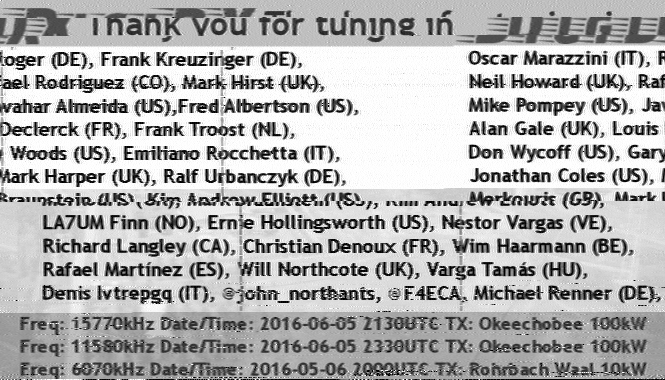
|

repuzzled structures // roger
Antialiasing = Kantenglättung |
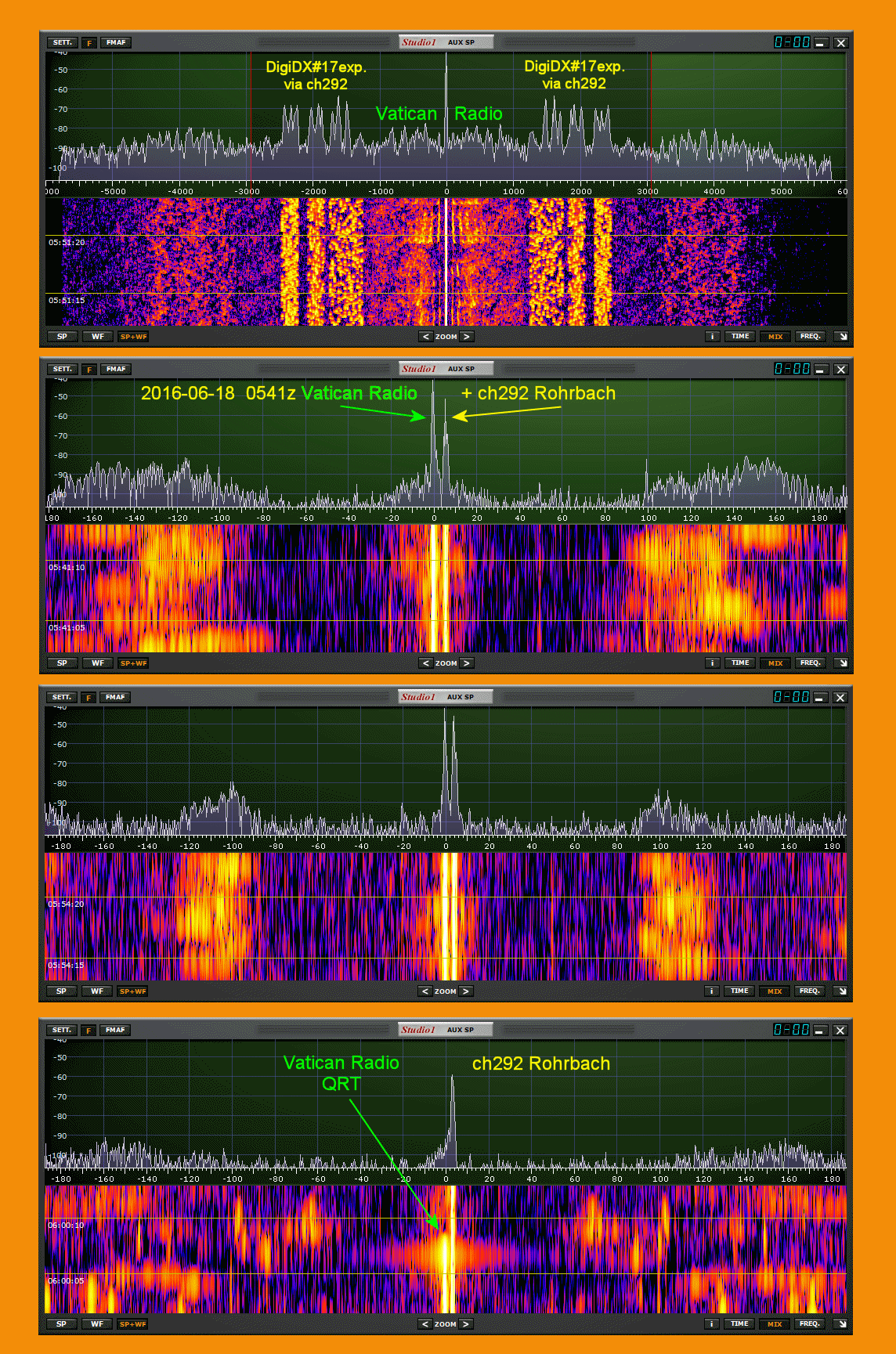
██╗ ██╗██████╗ ██████╗ ██████╗ █████╗ ██████╗ ██╗ ██████╗ ██████╗ ██████╗ █████╗ ███╗ ███╗
██║ ██╔╝██╔══██╗██╔════╝ ██╔══██╗██╔══██╗██╔══██╗██║██╔═══██╗██╔════╝ ██╔══██╗██╔══██╗████╗ ████║
█████╔╝ ██████╔╝██║ ██████╔╝███████║██║ ██║██║██║ ██║██║ ███╗██████╔╝███████║██╔████╔██║
██╔═██╗ ██╔══██╗██║ ██╔══██╗██╔══██║██║ ██║██║██║ ██║██║ ██║██╔══██╗██╔══██║██║╚██╔╝██║
██║ ██╗██████╔╝╚██████╗ ██║ ██║██║ ██║██████╔╝██║╚██████╔╝╚██████╔╝██║ ██║██║ ██║██║ ╚═╝ ██║
╚═╝ ╚═╝╚═════╝ ╚═════╝ ╚═╝ ╚═╝╚═╝ ╚═╝╚═════╝ ╚═╝ ╚═════╝ ╚═════╝ ╚═╝ ╚═╝╚═╝ ╚═╝╚═╝ ╚═╝
|
http://www.kbcradio.eu/
RSID: <<2016-06-12T1:31Z
MFSK-32 @
9925000+1500>>
The Italian Broadcasting Corporation (IBC) is now transmitting
digital modes (MFSK32, Olivia 16-500) Wednesdays at 2030-2100
UTC, part of its Wednesday broadcast at 2000-2200 UTC, on 6070
kHz, via Channel 292, Germany.
http://ibcradio.webs.com/
Reports to ibc@europe.com
|
Sending Pic:112x112C; |
webstream |
|
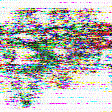 |
 |
Please report *this* decode to
themightykbc@gmail.com
██╗ ██╗ ██████╗ █████╗ ██████╗ █████╗ ██████╗ ██╗ ██████╗ ██████╗ ██████╗ █████╗ ███╗ ███╗
██║ ██║██╔═══██╗██╔══██╗ ██╔══██╗██╔══██╗██╔══██╗██║██╔═══██╗██╔════╝ ██╔══██╗██╔══██╗████╗ ████║
██║ ██║██║ ██║███████║ ██████╔╝███████║██║ ██║██║██║ ██║██║ ███╗██████╔╝███████║██╔████╔██║
╚██╗ ██╔╝██║ ██║██╔══██║ ██╔══██╗██╔══██║██║ ██║██║██║ ██║██║ ██║██╔══██╗██╔══██║██║╚██╔╝██║
╚████╔╝ ╚██████╔╝██║ ██║ ██║ ██║██║ ██║██████╔╝██║╚██████╔╝╚██████╔╝██║ ██║██║ ██║██║ ╚═╝ ██║
╚═══╝ ╚═════╝ ╚═╝ ╚═╝ ╚═╝ ╚═╝╚═╝ ╚═╝╚═════╝ ╚═╝ ╚═════╝ ╚═════╝ ╚═╝ ╚═╝╚═╝ ╚═╝╚═╝ ╚═╝
http://voaradiogram.net/
RSID: <<2016-06-11T16:01Z
MFSK-32 @
17580000+1500>>
Welcome to program 167 of VOA Radiogram from the Voice of
America.
I'm Kim Andrew Elliott in Washington.
Here is the lineup for today's program, all in MFSK32:
1:32 Program preview (now)
2:55 Four new chemical elements named*
7:21 New Russian medium-haul airliner*
11:13 In Russian: NASA astronaut selection process* **
18:40 Astronauts enter inflatable module on ISS*
24:20 Five days with no visible sunspots*
26:34 Closing announcements*
* with image
** Russian text requires UTF-8 character set. In Fldigi:
Configure > Colors & Fonts > set Rx/Tx Character set to UTF-8.
Please send reception reports to radiogram@voanews.com.
And visit voaradiogram.net.
Twitter: @VOARadiogram
Four New Elements Named on Periodic Table
VOA News
June 08, 2016
Chemistry students will now have to work just a little harder.
The International Union of Pure and Applied Chemistry announced
names for four new elements Wednesday.
Given the atomic numbers 113, 115, 117 and 118, the four new
elements have been named Nihonium (Nh), Moscovium (Mc),
Tennessine (Ts) and Oganesson (Og), respectively. Until now,
they'd been known by the Latin words for their atomic numbers:
ununtrium, ununpentium, ununseptium and ununoctium.
Elements can be named for a mythological concept or character, a
mineral or similar substance, a place or geographical region, a
property of the element, or a scientist.
And, of course, they must end in "-ium," "-ine" or "-on"
depending on the grouping of elements they belong to. IUPAC also
prefers the names translate easily across major languages.
The elements were named by the scientists in the U.S., Japan and
Russia who discovered them. The researchers hailed from the Joint
Institute for Nuclear Research in Dubna, Russia; Oak Ridge
National Laboratory in Tennessee; Vanderbilt University in
Tennessee; Lawrence Livermore National Laboratory in California;
and the RIKEN Nishina Center for Accelerator Based Science in
Japan.
So, Moscovium is named after Moscow; Tennessine is named after
the U.S. state where Oak Ridge and Vanderbilt University are
located; Nihon is one way of saying "Japan" in Japanese;
Oganesson is named after the 83-year-old Russian scientist Yuri
Oganessian. Oganesson is only the second element to be named
after a living scientist.
Tennessee is the second U.S. state to be recognized with an
element; California was the first.
The new names will now undergo a five-month public review to
allow for any potential objections.
In the meantime, the hunt for heavier elements, and the first
entry of the eighth row of the periodic table, continues.
http://www.voanews.com/content/four-new-elements-periodic-table/3368478.html
Sending Pic:203x114C;

This is VOA Radiogram from the Voice of America.
Please send reception reports to radiogram@voanews.com.
From Radio Free Europe/Radio Liberty:
Russia Rolls Out Jet To Challenge Boeing, Airbus
June 08, 2016
The Russian corporation Irkut has rolled out its new medium-haul
airliner as the country aims to challenge commercial
plane-industry leaders Boeing and Airbus.
The single-aisle MC-21, designed for up to 211 seats, was
introduced to the public on June 8 at the plant in the Siberian
city of Irkutsk.
"I am sure that the MC-21 airliner will take up its rightful
place in the world market," Prime Minister Dmitry Medvedev said
at the unveiling. "Russia must remain in the top league of
aviation producers."
The model is expected to replace the Soviet-era Tupolev Tu-154
and make their first test flights by the end of the year or in
early 2017.
With a range of nearly 6,400 kilometers, the MC-21 will take on
Boeing's 737 and Airbus's A320 series.
Based on reporting by AFP and Bloomberg
http://www.rferl.org/content/russia-introduces-passenger-jet-challenge-boeing-airbus/27786569.html
Sending Pic:247x151C;

This is VOA Radiogram from the Voice of America.
Please send reception reports to radiogram@voanews.com.
From the VOA Russian Service ...
В США отмечен рекордный конкурс среди желающих полететь в космос
ВАШИНГТОН - По данным НАСА, на программу подготовки астронавтов
2017 года подано рекордное количество заявок –18,300.
Космическому агентству потребуется полтора года, чтобы по
результатам тестирования скомплектовать группу из 14 человек.
Судя по конкурсу, попасть в космический отряд будет в 65 раз
сложнее, чем в число студентов Гарварда.
Несмотря на то, что полеты на орбиту стали сегодня практически
рутиной, заветная мечта стать космонавтом по-прежнему бередит умы
современников. Тем более, что на первоначальном этапе все
довольно просто: достаточно подать анкету в соответствующую
службу NASA. Другой вопрос – что именно вы укажете в своей
анкете. Как насчет диплома инженера, биолога, компьютерщика или
математика? Или, скажем, имеется ли у вас тысяча часов налета на
реактивных самолетах? Кроме обязательных тестов на
профессиональную и физическую подготовку, NASA также обращает
внимание на определенные личностные характеристики.
«Нас интересуют лидерские качества, умение работать в команде и
коммуникабельность. Эти характеристики, я уверена, будут не
лишними и для многих других профессий», – говорит Энн Роумер,
менеджер по отбору астронавтов, NASA. ...
Full text:
http://www.golos-ameriki.ru/content/nasa-space-volunteers/3365451.html
Sending Pic:301x42C;

This is VOA Radiogram from the Voice of America.
Please send reception reports to radiogram@voanews.com.
Astronauts Get First Look Inside Space Station's New Inflatable
Module
Reuters via voanews.com
June 06, 2016
CAPE CANAVERAL, FLORIDA - Astronauts aboard the International
Space Station on Monday floated inside an experimental inflatable
module that will test a less expensive and potentially safer
option for housing crews during long stays in space, NASA said.
Station flight engineers Jeff Williams and Oleg Skripochka opened
the hatch to the Bigelow Expandable Activity Module, or BEAM, at
4:47 a.m. EDT (0847 GMT) Monday.
Designed and built by privately-owned Bigelow Aerospace, BEAM is
the first inflatable habitat to be tested with astronauts in
space. The Las Vegas-based firm previously flew two unmanned
prototypes.
BEAM was flown to the space station aboard a SpaceX Dragon cargo
ship in April and inflated to the size of small bedroom on May
28. It is scheduled to remain attached to the station, a $100
billion research laboratory that flies about 250 miles (400 km)
above Earth, for two years.
Wearing face masks and headlamps, Williams and Skripochka floated
inside the darkened module for the first time to collect air
samples for analysis and retrieve engineering data from BEAM's
inflation.
Williams told flight controllers the module looked "pristine,"
mission commentator Gary Jordan said during a NASA TV broadcast.
Williams also said it was cold inside BEAM, but that there was no
sign of condensation on the walls, Jordan said.
Astronauts will return to BEAM on Tuesday and Wednesday to
install temperature and radiation sensors, as well as instruments
to collect data from any micro-meteoroid or orbital debris
impacts.
BEAM's hatch will remain closed except when astronauts go inside
the module six or seven times per year to retrieve recorded data,
NASA said.
Lightweight inflatables, which are made of layers of fabrics and
a protective outer shield, are far less costly to launch than
traditional metal modules. They may also provide astronauts with
better radiation protection.
"This technology can be used in future designs for a mission to
Mars," Jordan said.
Bigelow Aerospace is aiming to fly inflatable space modules 20
times larger than BEAM that can be leased out to companies and
research organizations.
http://www.voanews.com/content/astronauts-first-look-space-station-inflatable-module/3364855.html
Sending Pic:201x163C;

7 June marked the fifth day in a row with no visible sunspots ...
Sending Pic:182x183C;
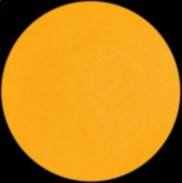
See:
http://www.arrl.org/news/sun-is-sunspot-free-for-fifth-straight-day
Please send reception reports to radiogram@voanews.com.
And visit voaradiogram.net.
Twitter: @VOARadiogram
Thanks to colleagues at the Edward R. Murrow shortwave
transmitting station in North Carolina.
I'm Kim Elliott. Please join us for the next VOA Radiogram.
This is VOA, the Voice of America.
Sending Pic:316x28C;

www.rhci-online.net/radiogram/radiogram.htm















